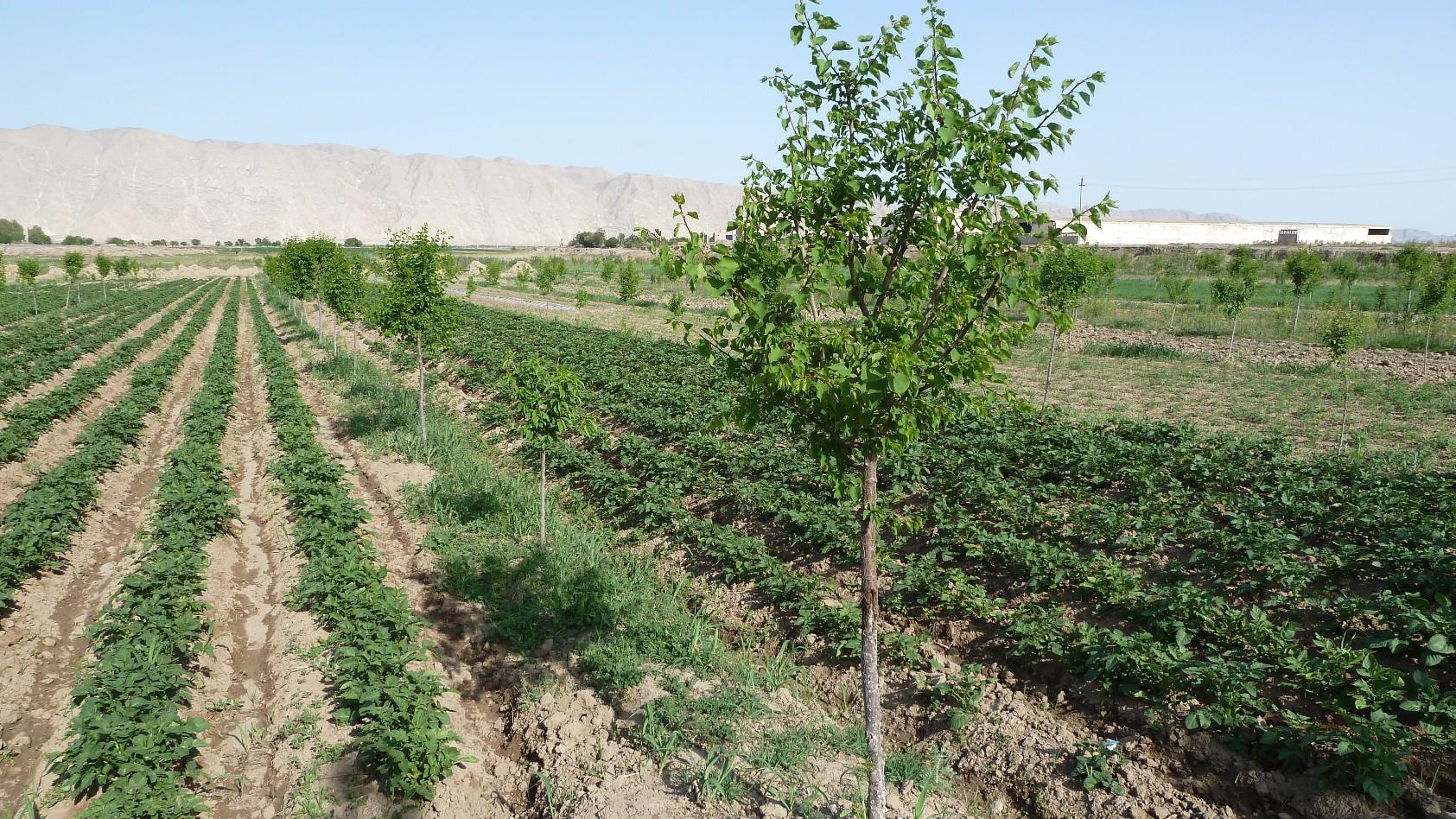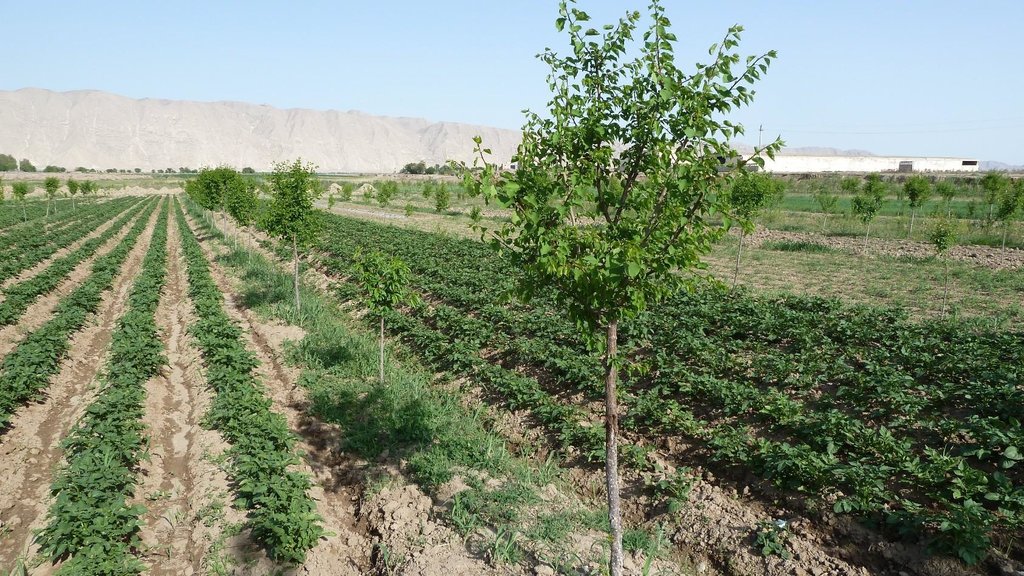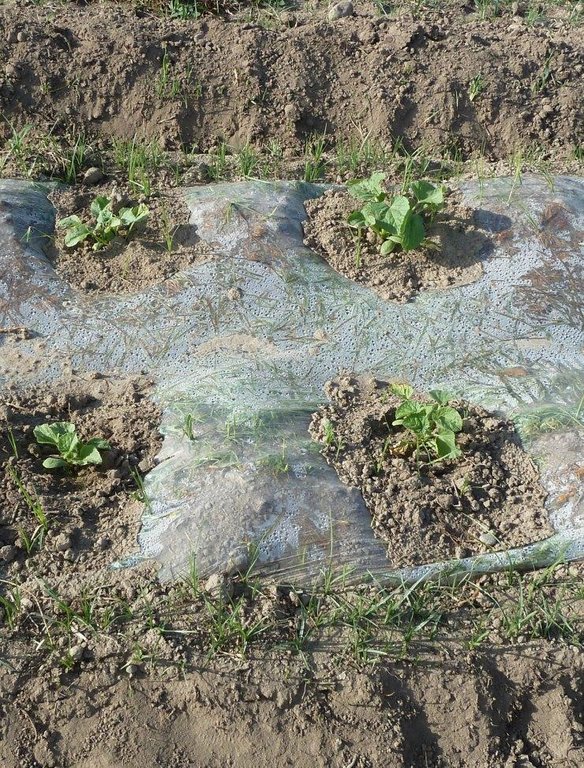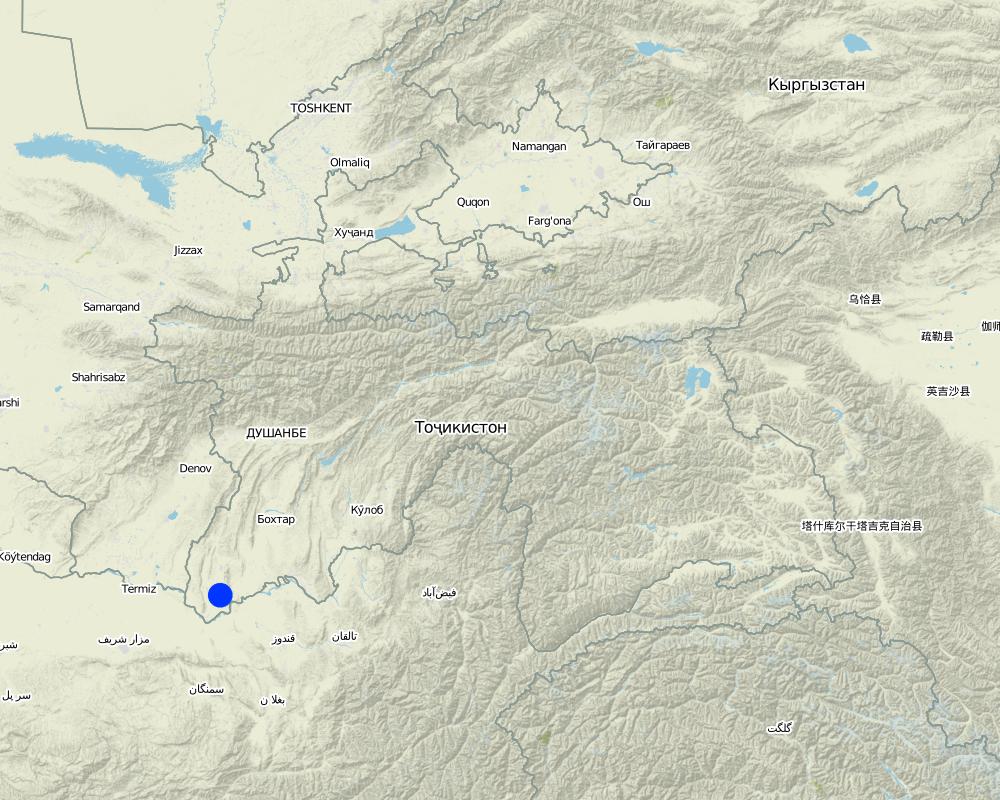Rehabilitation of poor soils through agroforestry [塔吉克斯坦]
- 创建:
- 更新:
- 编制者: Natalia Mityakova
- 编辑者: –
- 审查者: David Streiff, Alexandra Gavilano
Tajikistan - Central Asian Countries Initiative for Land Management (CACILM/ИСЦАУЗР)
technologies_1052 - 塔吉克斯坦
- Rehabilitation of poor soils through agroforestry: March 15, 2017 (inactive)
- Rehabilitation of poor soils through agroforestry: July 20, 2017 (inactive)
- Rehabilitation of poor soils through agroforestry: Aug. 21, 2019 (inactive)
- Rehabilitation of poor soils through agroforestry: Nov. 2, 2021 (public)
查看章节
全部展开 全部收起1. 一般信息
1.2 参与该技术评估和文件编制的资源人员和机构的联系方式
SLM专业人员:
SLM专业人员:
SLM专业人员:
Urakov Buran
UNDP
塔吉克斯坦
有助于对技术进行记录/评估的机构名称(如相关)
United Nations Development Program (United Nations Development Program) - 塔吉克斯坦有助于对技术进行记录/评估的机构名称(如相关)
CDE Centre for Development and Environment (CDE Centre for Development and Environment) - 瑞士有助于对技术进行记录/评估的机构名称(如相关)
Central Asian Countries Initiative for Sustainable Land Management - Multicountry Capacity Building (CACILM - MCB) - 吉尔吉斯斯坦1.3 关于使用通过WOCAT记录的数据的条件
编制者和关键资源人员接受有关使用通过WOCAT记录数据的条件。:
是
2. SLM技术的说明
2.1 技术简介
技术定义:
An agroforestry system with peach, plum, sweet cherry and persimmon trees was established on a plot of land, with poor soil quality.
2.2 技术的详细说明
说明:
In the arid environment of Kabodion, large areas that had been irrigated during the Soviet times were abandoned after independence, and the irrigation facilities were neglected. Soils were highly degraded due to the long periods they had been without proper irrigation. On an area of poor quality soil, and previously abandoned plot of land covering about 6 ha, UNDP supported one family (Dehkan)to establish an agroforestry system by covering the costs of tree seedlings.
Purpose of the Technology: The aim of the technology was to improve agricultural production through a combination of measures such as improving soil fertility, increasing soil humidity through covering the soil with plastic sheets and preventing excess water drainage, and protection through a shelterbelt. Resilience to adverse climatic events is enhanced by increasing product diversification with a number of different tree, vegetable and crop species being planted.
Establishment / maintenance activities and inputs: First, the soil had to be washed to reduce the high salt content. Plum, peach, sweet cherry and persimmon tree seedlings were planted in lines with intercropping of potatoes, watermelon, beans and wheat inbetween. The seedlings were purchased from the Kabodion nursery. Labour was provided in the form of "hashar" or voluntary neighbourhood help. On the windward side of the field, a shelterbelt consisting of White Poplar (Populus alba) trees was established to protect the field from wind erosion, and to reduce evapotranspiration. In order to improve soil structure annual crop rotations were practiced. Every 4 years 40 tones of cow dung are spread out per ha of land. The application of organic manure constitutes an important cost factor for the farmer, as 40 tons of manure costs about 180 to 220 USD. To improve soil humidity and to enable early planting for watermelons, cultivation seeds are planted under a tight plastic film with irrigation water filled underneath the sheet. As soon as the seedlings emerge a hole is made in the plastic to create space for the plants. Irrigation is applied only sparingly to prevent the soil from a new rise in salinity. The plot is situated on a gentle slope which facilitated the establishment of a drainage system by digging a trench at the foot of the field to absorb excess water. The farmer was able to cover the costs of this initial investment himself using the revenues from the first harvest. At the foot of this field, salt tolerant Russian Silverberry (Elaeagnus angustifolia) trees were planted to promote biodrainage to help prepare the adjacent land for conversion to agroforestry at a later stage. The farmer gained the knowledge that was necessary for the establishment of the system through attending the farmer field schools (see approach TAJ018).
Natural / human environment: This technology is suitable for other arid environments, and the economic benefits are high compared to the establishment and maintenance costs. When this was realised by the neighbouring farmers they adopted the technology on an area of land that was actually three times larger.
2.3 技术照片
2.5 已应用该技术的、本评估所涵盖的国家/地区/地点
国家:
塔吉克斯坦
区域/州/省:
Khatlon, Kabodion
有关地点的进一步说明:
Khudokulov Jamoat
具体说明该技术的分布:
- 适用于特定场所/集中在较小区域
注释:
Total area covered by the SLM Technology is 0.06 km2.
The technology was initially applied on 5.8 ha of denuded land, however, it has been spontaneously adopted by a neighbour who has about 18 ha.
Map
×2.6 实施日期
如果不知道确切的年份,请说明大概的日期:
- 不到10年前(最近)
2.7 技术介绍
详细说明该技术是如何引入的:
- 通过项目/外部干预
3. SLM技术的分类
3.1 该技术的主要目的
- 减少、预防、恢复土地退化
3.2 应用该技术的当前土地利用类型
同一土地单元内混合使用的土地::
是
具体说明混合土地使用(作物/放牧/树木):
- 农林业

农田
- 一年一作
- 乔木与灌木的种植
年作 - 具体指明作物:
- 豆科牧草和豆类 - 豆子
- 谷类 - 小麦(春季)
- 根/块茎作物 - 土豆
- watermelons
乔木和灌木种植 - 指定作物:
- 核果(桃、杏、樱桃、李子等)
- 仁果类(苹果、梨子、柑橘等)
- persimmons, Diospyros kaki, Prunus avium, Prunus persica, Prunus domestica, Elaeagnus angustifolia
每年的生长季节数:
- 2
具体说明:
Longest growing period in days: 240Longest growing period from month to month: October - May (winter wheat)Second longest growing period in days: 120Second longest growing period from month to month: June-September
注释:
Major land use problems (compiler’s opinion): degradation of vegetation cover, loss of topsoil through wind erosion, poor access to irrigation water,
Major land use problems (land users’ perception): salinity, waterlogging, low soil fertility, low agricultural production
Future (final) land use (after implementation of SLM Technology): Mixed: Mf: Agroforestry
3.3 由于技术的实施,土地使用是否发生了变化?
由于技术的实施,土地使用是否发生了变化?:
- 是(请在技术实施前填写以下有关土地利用的问题)
同一土地单元内混合使用的土地::
是
具体说明混合土地使用(作物/放牧/树木):
- 农林业

不毛之地
具体说明:
wastelands, deserts, glaciers, swamps, recreation areas, etc
3.4 供水
该技术所应用土地的供水:
- 充分灌溉
3.5 该技术所属的SLM组
- 农业林学
- 改良的地面/植被覆盖
- 改良植物品种/动物品种
3.6 包含该技术的可持续土地管理措施

农艺措施
- A1:植被和土壤覆盖层
- A2:有机质/土壤肥力
- A3:土壤表面处理

植物措施
- V1:乔木和灌木覆盖层

结构措施
- S3:分级沟渠、渠道、水道
注释:
Main measures: agronomic measures, vegetative measures
Secondary measures: structural measures
Type of agronomic measures: manure / compost / residues, rotations / fallows, furrows (drainage, irrigation)
Type of vegetative measures: aligned: -along boundary, aligned: -linear
3.7 该技术强调的主要土地退化类型

土壤风蚀
- Et:表土流失

化学性土壤退化
- Cn:肥力下降和有机质含量下降(非侵蚀所致)
- Cs:盐化/碱化

物理性土壤退化
- Pw:水浸

生物性退化
- Bc:植被覆盖的减少
- Bs:质量和物种组成/多样性的下降

水质恶化
- Ha:干旱化
注释:
Main type of degradation addressed: Cn: fertility decline and reduced organic matter content, Cs: salinisation / alkalinisation, Pw: waterlogging, Ha: aridification
Secondary types of degradation addressed: Et: loss of topsoil, Bc: reduction of vegetation cover, Bs: quality and species composition /diversity decline
Main causes of degradation: soil management (soils were under irrigation for a long time and had salinity problems), droughts, inputs and infrastructure: (roads, markets, distribution of water points, other, …) (breakdown of irrigation facilities), education, access to knowledge and support services (lack of knowledge about agroforestry), governance / institutional (no freedom to farm)
3.8 防止、减少或恢复土地退化
具体数量名该技术与土地退化有关的目标:
- 修复/恢复严重退化的土地
注释:
Main goals: rehabilitation / reclamation of denuded land
4. 技术规范、实施活动、投入和成本
4.1 该技术的技术图纸
技术规范(与技术图纸相关):
Technical knowledge required for field staff / advisors: moderate
Technical knowledge required for land users: moderate
Main technical functions: control of concentrated runoff: drain / divert, improvement of ground cover, increase in organic matter, increase in nutrient availability (supply, recycling,…), increase of infiltration, reduction in wind speed
Secondary technical functions: increase of biomass (quantity), promotion of vegetation species and varieties (quality, eg palatable fodder)
Manure / compost / residues
Material/ species: organic manure
Quantity/ density: 40 tones
Remarks: ha
Rotations / fallows
Material/ species: annual crop rotation
Furrows (drainage, irrigation)
Material/ species: drainage
Aligned: -along boundary
Vegetative material: T : trees / shrubs
Aligned: -linear
Vegetative material: F : fruit trees / shrubs
Number of plants per (ha): 845
Spacing between rows / strips / blocks (m): 10
Vertical interval within rows / strips / blocks (m): 3
Trees/ shrubs species: Elaeagnus angustifolia (for shelterbelt and fence around plot)
Fruit trees / shrubs species: Diospyros kaki, Prunus avium, Prunus persica, Prunus domestica
Diversion ditch/ drainage
Depth of ditches/pits/dams (m): 1.5
Width of ditches/pits/dams (m): 1
Length of ditches/pits/dams (m): 200
4.2 有关投入和成本计算的一般信息
其它/国家货币(具体说明):
SOM
如相关,注明美元与当地货币的汇率(例如1美元=79.9巴西雷亚尔):1美元=:
4.5
注明雇用劳工的每日平均工资成本:
20.00
4.3 技术建立活动
| 活动 | 时间(季度) | |
|---|---|---|
| 1. | Planting of tree seedlings in field and along boundary | early spring |
| 2. | Digging up irrigation ditch at the foot of the field |
4.4 技术建立所需要的费用和投入
| 对投入进行具体说明 | 单位 | 数量 | 单位成本 | 每项投入的总成本 | 土地使用者承担的成本% | |
|---|---|---|---|---|---|---|
| 劳动力 | Planting of tree seedlings | Persons/day | 50.0 | 20.0 | 1000.0 | 100.0 |
| 劳动力 | Digging up irrigation ditch | Persons/day | 40.0 | 20.0 | 800.0 | 100.0 |
| 设备 | Machine use | ha | 1.0 | 274.0 | 274.0 | |
| 设备 | 1.0 | |||||
| 植物材料 | Tree seedlings | pieces | 844.0 | 3.14573 | 2655.0 | |
| 技术建立所需总成本 | 4729.0 | |||||
| 技术建立总成本,美元 | 1050.89 | |||||
4.5 维护/经常性活动
| 活动 | 时间/频率 | |
|---|---|---|
| 1. | Annual crop rotation | |
| 2. | Application of organic manure | every 4 years |
| 3. | Cover soil around crops with plastic cover | early planting season |
| 4. | Tillage | |
| 5. | Continuous daily irrigation for tree seedlings | daily during hot months |
4.6 维护/经常性活动所需要的费用和投入(每年)
| 对投入进行具体说明 | 单位 | 数量 | 单位成本 | 每项投入的总成本 | 土地使用者承担的成本% | |
|---|---|---|---|---|---|---|
| 劳动力 | Daily irrigation for tree seedlings | Persons/day | 186.0 | 20.0 | 3720.0 | 100.0 |
| 肥料和杀菌剂 | Organic/manure | tons | 40.0 | 25.0 | 1000.0 | |
| 施工材料 | Plastic cover | m | 1.0 | 1.8 | 1.8 | 100.0 |
| 其它 | Tillage | ha | 1.0 | 430.0 | 430.0 | |
| 技术维护所需总成本 | 5151.8 | |||||
| 技术维护总成本,美元 | 1144.84 | |||||
注释:
Costs were calculated per ha. Labour costs for irrigation of tree seedlings were calculated assuming that one person has to irrigate daily during 6 months of the year and were included under annual recurring costs.
4.7 影响成本的最重要因素
描述影响成本的最决定性因素:
The cost of the tree seedlings is the most determinate factor. Labour costs are high if labour has to be paid, however, in this case labour is provided free by the farmer.
5. 自然和人文环境
5.1 气候
年降雨量
- < 250毫米
- 251-500毫米
- 501-750毫米
- 751-1,000毫米
- 1,001-1,500毫米
- 1,501-2,000毫米
- 2,001-3,000毫米
- 3,001-4,000毫米
- > 4,000毫米
指定年平均降雨量(若已知),单位为mm:
100.00
农业气候带
- 干旱
Thermal climate class: temperate
5.2 地形
平均坡度:
- 水平(0-2%)
- 缓降(3-5%)
- 平缓(6-10%)
- 滚坡(11-15%)
- 崎岖(16-30%)
- 陡峭(31-60%)
- 非常陡峭(>60%)
地形:
- 高原/平原
- 山脊
- 山坡
- 山地斜坡
- 麓坡
- 谷底
垂直分布带:
- 0-100 m a.s.l.
- 101-500 m a.s.l.
- 501-1,000 m a.s.l.
- 1,001-1,500 m a.s.l.
- 1,501-2,000 m a.s.l.
- 2,001-2,500 m a.s.l.
- 2,501-3,000 m a.s.l.
- 3,001-4,000 m a.s.l.
- > 4,000 m a.s.l.
5.3 土壤
平均土层深度:
- 非常浅(0-20厘米)
- 浅(21-50厘米)
- 中等深度(51-80厘米)
- 深(81-120厘米)
- 非常深(> 120厘米)
土壤质地(表土):
- 粗粒/轻(砂质)
表土有机质:
- 低(<1%)
如有可能,附上完整的土壤描述或具体说明可用的信息,例如土壤类型、土壤酸碱度、阳离子交换能力、氮、盐度等。:
Soil fertility is low
Soil drainage / infiltration is poor: water logging occurs
Soil water storage capacity is low
5.4 水资源可用性和质量
地下水位表:
< 5米
地表水的可用性:
匮乏/没有
水质(未处理):
仅供农业使用(灌溉)
关于水质和水量的注释和进一步规范:
Ground water table: Too high, danger of waterlogging
5.5 生物多样性
物种多样性:
- 低
5.6 应用该技术的土地使用者的特征
生产系统的市场定位:
- 混合(生计/商业)
非农收入:
- 低于全部收入的10%
个人或集体:
- 个人/家庭
机械化水平:
- 手工作业
- 机械化/电动
说明土地使用者的其他有关特征:
Land users applying the Technology are mainly common / average land users
Population density: 50-100 persons/km2
Annual population growth: 2% - 3%
Level of mechanization: Land cultivation is a mixture of mechanisation and manual labour
5.7 应用该技术的土地使用者使用的平均土地面积
- < 0.5 公顷
- 0.5-1 公顷
- 1-2 公顷
- 2-5公顷
- 5-15公顷
- 15-50公顷
- 50-100公顷
- 100-500公顷
- 500-1,000公顷
- 1,000-10,000公顷
- > 10,000公顷
这被认为是小规模、中规模还是大规模的(参照当地实际情况)?:
- 中等规模的
注释:
6 ha
5.8 土地所有权、土地使用权和水使用权
土地所有权:
- 州
土地使用权:
- 个人
注释:
family Dehkan farm
5.9 进入服务和基础设施的通道
健康:
- 贫瘠
- 适度的
- 好
教育:
- 贫瘠
- 适度的
- 好
技术援助:
- 贫瘠
- 适度的
- 好
就业(例如非农):
- 贫瘠
- 适度的
- 好
市场:
- 贫瘠
- 适度的
- 好
能源:
- 贫瘠
- 适度的
- 好
道路和交通:
- 贫瘠
- 适度的
- 好
饮用水和卫生设施:
- 贫瘠
- 适度的
- 好
金融服务:
- 贫瘠
- 适度的
- 好
6. 影响和结论性说明
6.1 该技术的现场影响
社会经济效应
生产
作物生产
饲料生产
注释/具体说明:
lucerne (alfalfa) production
生产故障风险
注释/具体说明:
diversification
产品多样性
生产区域
注释/具体说明:
before the land was denuded
社会文化影响
食品安全/自给自足
健康状况
注释/具体说明:
vitamin-rich fruits are more readily available
SLM/土地退化知识
注释/具体说明:
through participation in farmer field schools
冲突缓解
注释/具体说明:
jealousy by other land users who would like to cultivate this land now they can see how productive it is
Livelihood and human well-being
注释/具体说明:
Farmer does not need to migrate to Russia anymore to find work, and could afford to buy a house.
生态影响
水循环/径流
多余水的排放
蒸发
土壤
土壤水分
土壤覆盖层
土壤压实
养分循环/补给
盐度
土壤有机物/地下C
生物多样性:植被、动物
生物量/地上C
植物多样性
减少气候和灾害风险
风速
6.3 技术对渐变气候以及与气候相关的极端情况/灾害的暴露和敏感性(土地使用者认为的极端情况/灾害)
渐变气候
渐变气候
| 季节 | 增加或减少 | 该技术是如何应对的? | |
|---|---|---|---|
| 年温度 | 增加 | 好 |
气候有关的极端情况(灾害)
气象灾害
| 该技术是如何应对的? | |
|---|---|
| 局地暴雨 | 好 |
| 局地风暴 | 好 |
气候灾害
| 该技术是如何应对的? | |
|---|---|
| 干旱 | 不好 |
水文灾害
| 该技术是如何应对的? | |
|---|---|
| 比较和缓的(河道)洪水 | 不好 |
其他气候相关的后果
其他气候相关的后果
| 该技术是如何应对的? | |
|---|---|
| 缩短生长期 | 好 |
6.4 成本效益分析
技术收益与技术建立成本相比如何(从土地使用者的角度看)?
短期回报:
非常积极
长期回报:
非常积极
技术收益与技术维护成本/经常性成本相比如何(从土地使用者的角度看)?
短期回报:
非常积极
长期回报:
非常积极
注释:
In the beginning the farmer was not sure about the short-term benefits, but he confirmed that even after just two years he received eight times more than what he invested initially.
6.5 技术采用
- 单例/实验
如若可行,进行量化(住户数量和/或覆盖面积):
1 household
在所有采用这项技术的人当中,有多少人是自发的,即未获得任何物质奖励/付款?:
- 11-50%
注释:
100% of land user families have adopted the Technology with external material support
1 land user families have adopted the Technology with external material support
There is a strong trend towards spontaneous adoption of the Technology
Comments on adoption trend: Already 10 other farmers who noticed the success of this plot, have adopted this technology themselves.
Neighbour applied technologie spontaenously.
6.7 该技术的优点/长处/机会
| 土地使用者眼中的长处/优势/机会 |
|---|
| Improved livelihood as revenues are greater than those gained as a seasonal worker in Russia and enough capital produced to buy own house |
| Feeling confident about the future |
|
Improved yields How can they be sustained / enhanced? continue with application of organic manure, soil cover with plastic sheets, crop rotation, integrated pest management etc. |
| 编制者或其他关键资源人员认为的长处/优势/机会 |
|---|
|
Greatly increased income opportunity in an arid environment How can they be sustained / enhanced? disseminate knowledge to other farmers in the region |
| Diversified system and therefore reduced risk of production failure |
6.8 技术的弱点/缺点/风险及其克服方法
| 土地使用者认为的弱点/缺点/风险 | 如何克服它们? |
|---|---|
| increased conflicts as land users who used to cultivate this land before and gave up would now like to have the land back. |
7. 参考和链接
7.1 信息的方法/来源
链接和模块
全部展开 全部收起链接
无链接
模块
无模块





